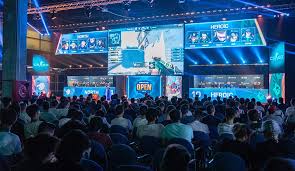Esports has rapidly evolved from a niche activity to a global phenomenon that rivals traditional sports in terms of popularity and viewership. With millions of fans and participants worldwide, see more on how the growth of esports is transforming the way people view competitive sports .
1. The Rise of Esports and Its Growing Popularity
Over the past decade, the esports industry has experienced phenomenal growth, both in terms of audience and revenue. Platforms like Twitch and YouTube have made it easier for fans to access live tournaments and engage with content. This ease of access has allowed esports to attract a younger, tech-savvy audience, boosting its global viewership significantly.
2. Social Media and Streaming in Esports
Social media platforms and streaming services have been crucial in the rise of esports. Platforms like Twitch and YouTube have created a space where fans can interact with their favorite players, follow tournaments, and discuss strategies. This level of engagement is often more direct and interactive compared to traditional sports, which has led to a new standard of fan participation and community building.
3. Esports and Gambling: A New Avenue of Revenue
The integration of betting and gambling in esports has opened up a lucrative revenue stream for the industry. Many online casinos and sportsbooks now offer betting options for major esports tournaments, similar to traditional sports betting. This trend has attracted sponsors and investors, adding further credibility and financial backing to esports.
4. Accessibility: Lower Barriers to Entry
One of the main reasons for the widespread appeal of esports is its low barrier to entry. Unlike traditional sports, which often require specific physical abilities and access to expensive facilities or equipment, esports can be played by anyone with access to a computer or gaming console. This has made esports accessible to a broader audience, including those who may not typically engage in conventional sports.
5. Sponsorship and Professionalization
As the esports industry has grown, it has attracted sponsorship deals from major brands, leading to the professionalization of the industry. These partnerships have allowed for larger prize pools, well-organized tournaments, and financial support for players and teams. The structure of esports has become more formalized, with player unions, leagues, and international tournaments, making it comparable to traditional sports.
Click here : https://devtuc.com/
6. The Impact on Traditional Sports
The rise of esports has had a noticeable impact on traditional sports. As younger generations gravitate more towards digital entertainment, traditional sports are losing viewership. This trend has prompted traditional sports organizations to explore ways to integrate esports, either by establishing their own esports teams or by partnering with existing esports organizations. These collaborations aim to blend physical and digital experiences, creating a more holistic entertainment option.
7. Esports vs. Traditional Sports: Similarities and Differences
While esports and traditional sports share similarities like competition, skill, and teamwork, there are significant differences in how they are governed and monetized. Esports is heavily influenced by game developers, who control the rules, updates, and monetization of the games. This level of control is unlike traditional sports, where rules are governed by independent organizations. However, both industries rely on a combination of professional and amateur players, competitive structures, and fan engagement.
8. The Integration of Esports and Traditional Sports
Esports and traditional sports are increasingly finding ways to complement each other. Some traditional sports organizations are exploring the idea of integrating esports into their offerings, and there is ongoing discussion about including esports in events like the Olympics. This integration presents both opportunities and challenges, particularly around governance, revenue sharing, and maintaining the integrity of each sport.
9. Financial Comparisons: Esports vs. Traditional Sports
Esports companies have started to reach valuations comparable to traditional sports franchises. Some of the top esports teams are now valued at over $300 million, rivaling smaller franchises in leagues like the NHL. Although the gap between esports and top-tier sports leagues like the NFL remains significant, esports is steadily closing the gap, signaling a bright future for competitive gaming.
10. The Future of Esports and Its Impact on Traditional Sports
The future of esports is promising, with continued growth in viewership, sponsorship, and player participation. As esports becomes more established, it will likely influence traditional sports further, setting new standards for fan engagement, content delivery, and monetization strategies. The ongoing debate over whether esports should be considered a sport will continue as both industries evolve and potentially merge in various capacities.
Conclusion: A New Era of Sports and Entertainment
The impact of esports on traditional sports is profound and continues to grow. Unlocking opportunities for collaboration, esports has already begun to shape how sports organizations view fan engagement and revenue generation. As the lines between digital and physical sports continue to blur, we are witnessing the beginning of a new era where both can co-exist, learn from each other, and thrive in the modern entertainment landscape.

